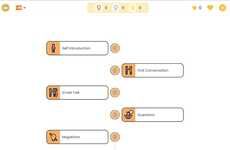
Low-Impact Aerobics Help the Japanese Learn English
Katie Cordrey — January 21, 2010 — Pop Culture
References: wtfjapanseriously
There is educational theory that postulates movement assists learning. Maybe that’s the idea behind the Japanese videos that use scantily-clad women, synchronized movement and word repetition to help the Japanese learn English.
When learning a foreign language, most of us learn phrases that will let us eat, sleep, find a restroom and navigate to the next tourist attraction. Apparently, the Japanese view of English-speaking countries necessitates learning phrases that can be used during muggings and after eating disagreeable food.
You really have to watch the videos to appreciate how the Japanese learn English.
When learning a foreign language, most of us learn phrases that will let us eat, sleep, find a restroom and navigate to the next tourist attraction. Apparently, the Japanese view of English-speaking countries necessitates learning phrases that can be used during muggings and after eating disagreeable food.
You really have to watch the videos to appreciate how the Japanese learn English.
Trend Themes
1. Multisensory Language Learning - Using movement and other senses beyond hearing and sight to aid foreign language learning
2. Edutainment Fitness - Combining education and fitness to create a more engaging and effective learning experience
3. Culturally-targeted Fitness - Fitness programs designed specifically for different cultures to better align with their learning and sensory preferences
Industry Implications
1. Education - Integrating more movement and other senses such as smell and touch into language learning curriculums
2. Fitness - Developing edutainment fitness programs that integrate educational content into aerobic exercises
3. Media and Entertainment - Creating culturally-targeted fitness content that is aligned with different cultures' learning and sensory preferences
1.6
Score
Popularity
Activity
Freshness























